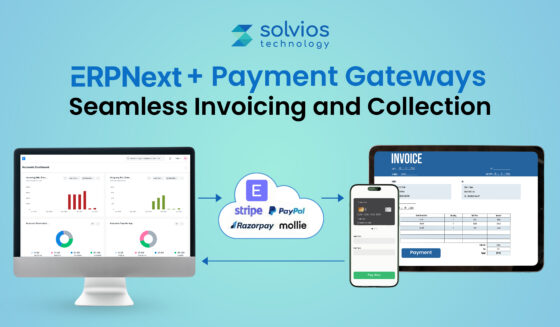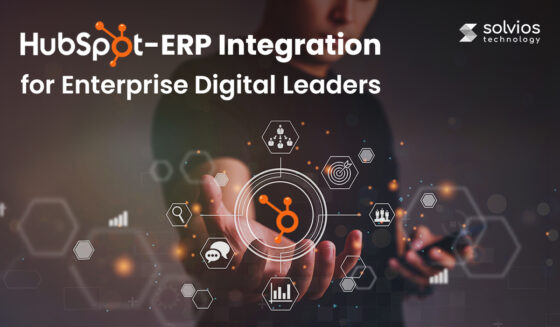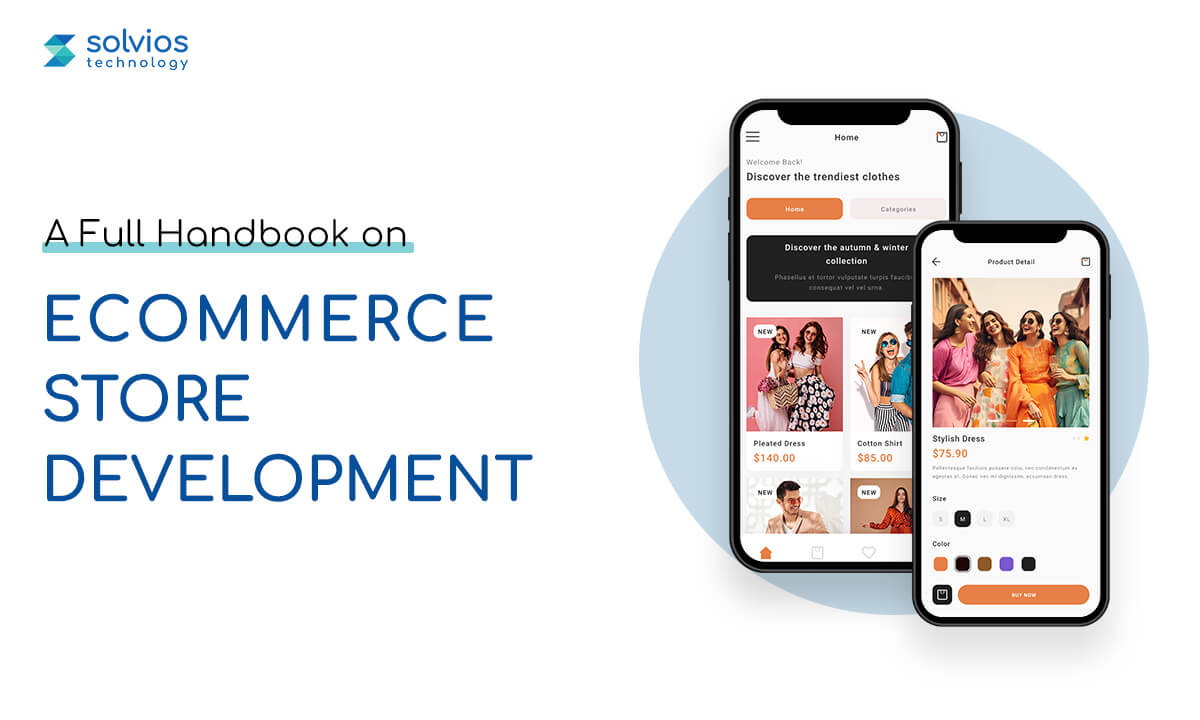
Recently, the word e-commerce has become the most admired word by businesses all over the world. E-commerce is nothing but electronic commerce, which enables traders to trade goods and services on the Internet. Knowing the demand, eCommerce web development companies worldwide start offering a comprehensive range of eCommerce Store Development services according to their client’s needs.
Well, before engaging or hiring any eCommerce web development agency or companies, e-retailers must know the importance and necessity of having a well-developed eCommerce website for selling retail products and services.
Key Benefits of eCommerce Website for Business
Here are the lists of a few key benefits companies or businesses can get through a well-developed eCommerce website.

- Can easily build a customer email list and engage with them directly.
- Establishing and strengthening a brand becomes much easier.
- Business owners can understand their customers more and customize their services accordingly.
- Easily run successful and creative marketing campaigns.
Having a well-developed eCommerce website will take company revenues and business expansion levels to new heights. According to the stats published in Statista, in 2024 retail eCommerce sales were estimated at USD 6.9 trillion. And the numbers are expected to grow at a steep rate in upcoming years.
This blog gives a complete guide on eCommerce, take a look and be wise in picking the right eCommerce platform for business expansion.
- Key Benefits of eCommerce Website for Business.
- Types of eCommerce business models.
- Essential Features and Functionalities for eCommerce Websites.
- Must-have Features of eCommerce Website to Boost Online Sales.
- Factors That Affect E-commerce Website Development Costs.
- How Businesses Should Plan Their E-commerce Website?
- Factors Considerations for eCommerce UX Design.
- Key Attributes of High-Performance eCommerce Store Development.
- Tips for Choosing Domain and Hosting.
- Hidden Costs Evaluation in Choosing Web Hosting.
- Tips for Optimizing Your Hosting Expenses.
- The Best eCommerce Store Development Process To Follow.
- Tips to Hire Developers and Agencies.
- Effective SEO and Marketing Strategies
- Conclusion
What are The Types of eCommerce Business Models?
In the recent past, the e-commerce industry has revolutionized in many ways to satisfy the customer’s needs, especially the way they shop and for business people to trade and interact with customers. Growing competition and improving customer experience have led to a burgeoning eCommerce industry. This revolution has led to the introduction of various eCommerce models to facilitate the transactions of businesses from various verticals.
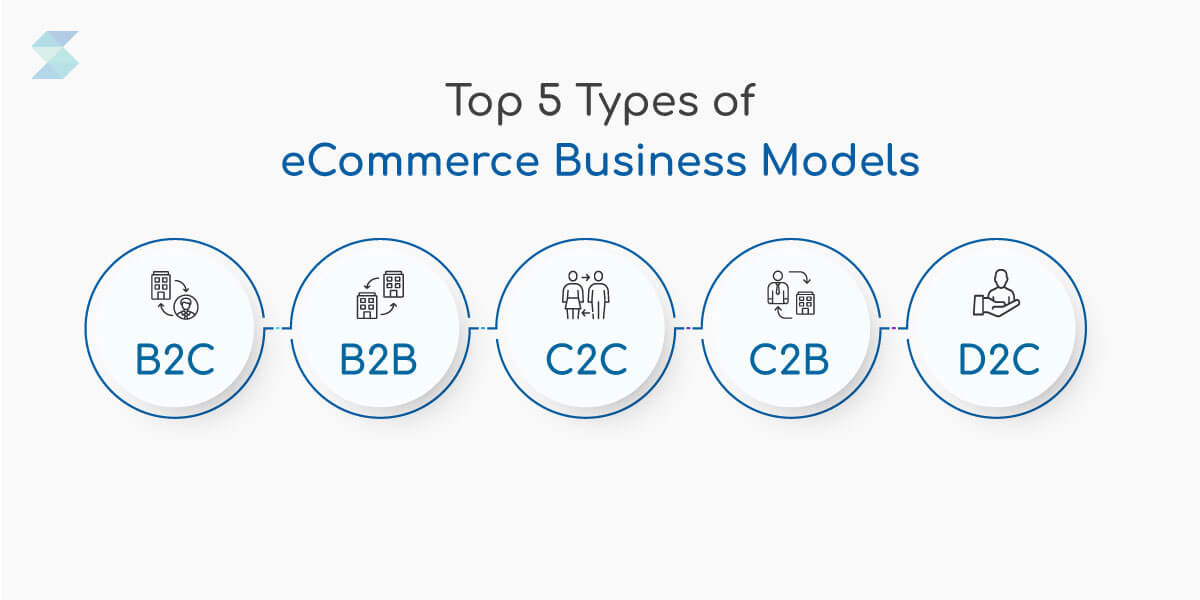
This section covers the 4 main eCommerce business models that facilitate eCommerce websites by providing essential tools and functions.
1. B2C (Business to Consumer)
Business-to-consumer, describes a particular kind of relationship that exists between a company and its clients. Instead of selling goods or services to companies or organizations, B2C eCommerce involves businesses selling products or services directly to consumers. This model typically includes online retail stores, subscription services, and digital product sales. The fitness apparel and accessories Gymshark would be the perfect example of a B2C eCommerce model. Gymshark is the direct seller of clothing and fitness accessories to customers.
Key features of B2C
- Personalized user experiences
- Targeted marketing
- Streamlined checkout processes
2. B2B (Business to Business)
Business-to-business, is a type of e-commerce where two or more businesses exchange goods and services. It is used to facilitate transactions between companies, such as manufacturers, wholesalers, distributors, and retailers. Amazon Business is an apt example of a B2B eCommerce business model. Amazon business offers an e-commerce platform allowing businesses of all sizes to interact and purchase products in bulk at discounted prices along with additional benefits.
Key features of B2B
- Bulk ordering capabilities
- Custom pricing options
- Integrated inventory management
3. C2C (Consumer to Consumer)
Consumer to Consumer describes a particular kind of online business where people exchange goods and services. C2C platform users can post the products and services for sale, interact with possible customers, and carry out transactions. eBay is a well-known C2C e-commerce platform where businesses can enjoy great benefits through it. It allows customers to find good and hard-to-find products from various sellers at a fixed price or auctions.
Key features of C2C
- Easy registration
- Product listings, search functionality
- Ratings and reviews on products
- Secure payment systems,
- Dispute resolution mechanisms.
- Messaging system
4. C2B (Consumer to Business)
C2B eCommerce is an online platform that enables companies to communicate with clients directly and offer goods and services. Customers can use it to get goods and services without leaving their homes and without going to a physical store. Google AdSense would be the perfect example of the C2B business model. This online advertising platform from Google allows consumers to earn money by placing ads on their highly trafficked websites based on their ad category choice and payment preferences.
Key features of C2B
- Easy user interface
- Wide range of products
- Secure payments
- Customized shopping experiences
- Resourceful customer support
- Variety of delivery options – same-day delivery, express delivery, and more.
5. D2C (Direct-to-Consumer)
Direct-to-consumer describes a particular kind of relationship that exists between consumers and wholesalers/ retailers without intermediaries. Instead of selling goods/products to intermediaries Direct-to-consumer (D2C), eCommerce involves wholesalers/ retailers selling products or services directly to consumers. One of the best examples of this model is Peloton which sells its product through its website, kiosk locations, and physical stores.
Key features of D2C
- Agile Operations
- Direct Sales Channels
- Data-Driven Marketing
- Brand Control and Ownership
Essential Features and Functionalities for eCommerce Websites
- Product Search and Filtering Options – Offering customers access to a range of payment options, such as credit cards, debit cards, digital wallets, and other payment methods, through integration with multiple payment processors.
- Personalized user accounts – Offering shoppers the ability to create an individual account. It enables customers/users to access purchase history, pre-defined payment options, custom product recommendations, tailored product filters, and faster order tracking.
- Shopping Experience: It’s become a mandate for eCommerce solution providers to facilitate shoppers with features and functions like cart functionalities, highly secured & multiple payment gateways, and easy-to-navigate user-friendly UI/UX for providing a smoother shopping experience.
- Advanced Security- The advanced security features such as multi-factor authentication, encryption, and fraud detection to protect customer data and transactions.
- Live Chat- A live chat feature to the site to allow customers to quickly and easily communicate with customer service representatives.
- Tracking and Analytics- Implementing tracking and analytics tools to gain insights into customer behavior and interactions with the website.
- Social Media Integration- Integrating these features, along with social media marketing services, ensures your eCommerce store not only attracts customers but also converts them into loyal buyers.
- Automated Email Marketing- This feature works like email campaigns to send customers product recommendations, special offers, and other promotional messages.
- Reward Scheme- Offering programs to customers as a way to express appreciation for purchases and encourage existing customers to continue shopping on the site.
Must-have Features of eCommerce Website to Boost Online Sales
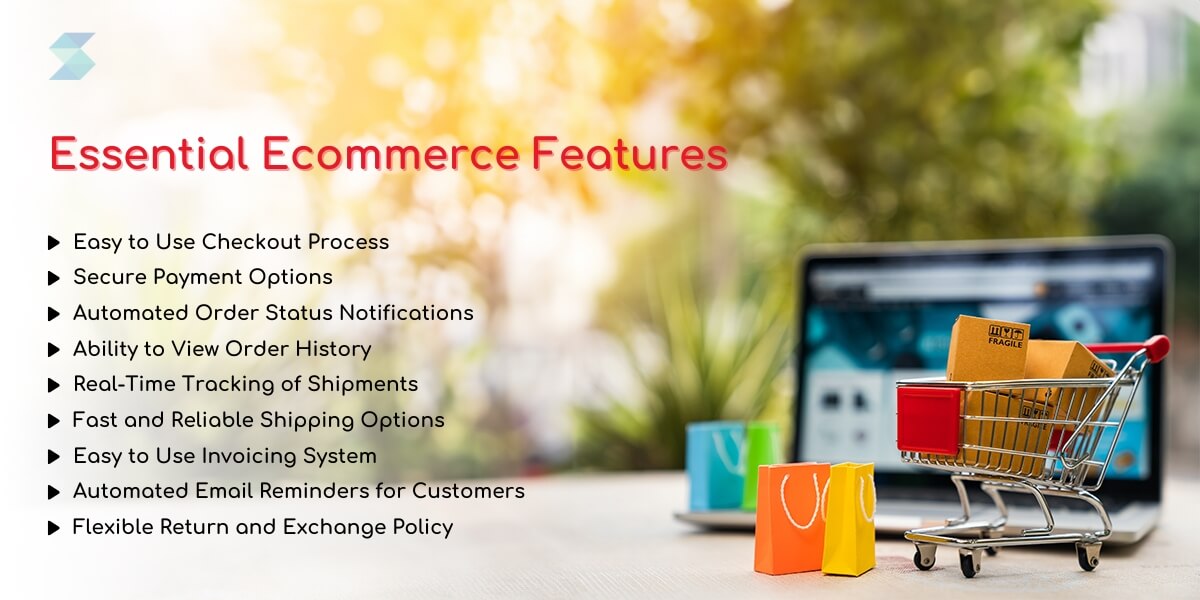
Apart from those above-listed essential functionalities and features of an eCommerce website, here are the additional features businesses can prefer having in their eCommerce store development.
Launching a successful eCommerce business necessitates investing in the appropriate website capabilities and functionality. Providing an outstanding online shopping experience is crucial for attracting and converting customers. Some of the optimal features convert occasional visitors into loyal, repeat purchasers.
- Easy to use checkout process: Offer a straightforward checkout flow that limits unnecessary steps. Allow guest checkout without creating an account to remove friction. Include auto-save payment options for express 1-click checkout on future purchases. Use responsive design principles to optimize checkout on all devices.
- Secure payment options: Integrate diverse payment gateways like Stripe, PayPal, Apple Pay, etc. to enable payment via credit cards, debit cards, net banking, mobile wallets, and more. Maintain PCI compliance and implement security features like HTTPS, SSL, and fraud analysis to protect customer data. Offer easy onboarding for new payment methods.
- Automated order status notifications: Provide real-time order status updates across multiple channels like SMS, email, and account order history. Send confirmations at key stages – order received, confirmed, shipped, out for delivery, delivered. Enable customers to track statuses without contacting support.
- Ability to view order history: Allow customers to access full order history with all details – order date, items, quantity, price, discounts, taxes, shipping, tracking number, and status. Enable sorting, filtering, and 1-click reordering from history.
- Real-time tracking of shipments: Integrate shipping carrier APIs to provide real-time tracking maps showing order progress. Sync tracking between emails, SMS, order history, and separate tracking page. Offer detailed logging of each shipping milestone.
- Fast and reliable shipping options: Offer customers fast shipping choices like next-day, and 2-day express shipping with clear delivery estimates per option. Partner with reputable carriers known for timely delivery. Provide options for expedited handling and shipping.
- Easy-to-use invoicing system: Allows customers to access, view, download, and print invoices for completed orders. Invoices should contain purchase details, product info, pricing, taxes, billing and shipping addresses, payment info, and policy info.
- Automated email reminders for customers: Trigger automated reminders via email if a cart is abandoned, including a discount promo code to complete the purchase. Send reminders 24 hours, and 48 hours after cart creation. Integrate SMS reminders in addition to email.
- Comprehensive customer support: Offer 24/7 customer support via channels like phone, email, and live chat. Ensure well-trained agents can resolve issues quickly and knowledgeably. Document common issues and resolutions in the help center/FAQ.
- Flexible return and exchange policy: Allow effortless self-service returns and exchanges within 10-15 days of delivery. Provide pre-paid return shipping labels and enable in-app return requests. Offer a refund upon inspection of the return.
Factors That Affect Ecommerce Website Development Costs
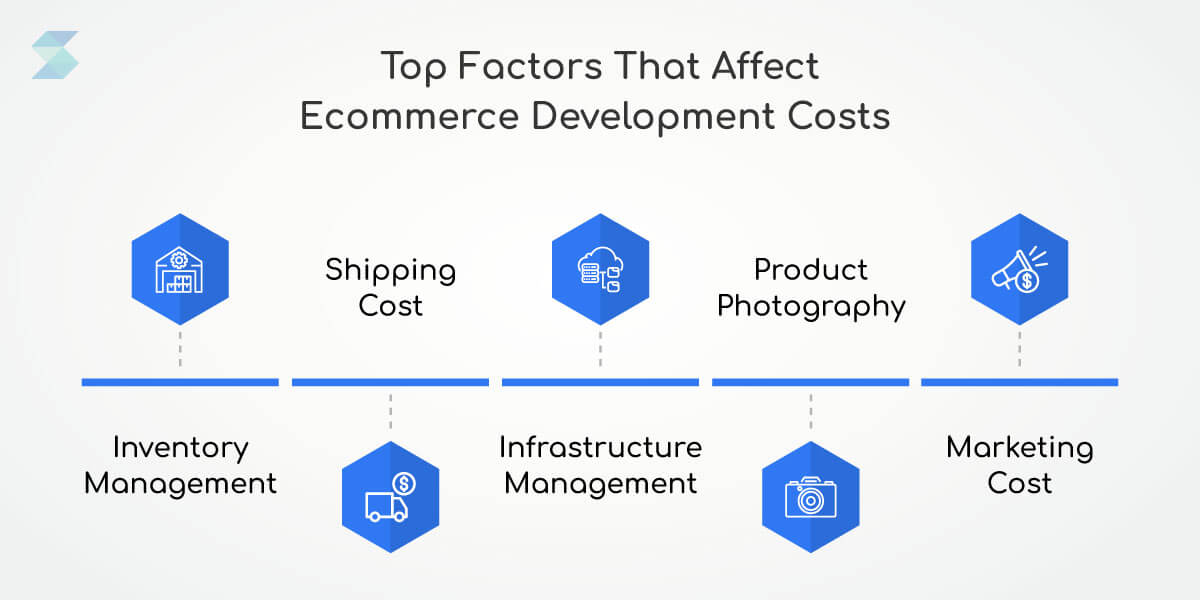
- Inventory Management & Shipping Cost – Depending on a company’s size and complexity, inventory and shipping cost management may be costly. It can be done with inventory & shipping management software or an Excel spreadsheet.
- Infrastructure Management – From managing servers to Content Delivery Network (CDN), Database Management, and so on – managing infrastructure plays an important role in key cost considerations while developing eCommerce sites. Spending much on the right infrastructure sync with your strategies helps to achieve business goals while choosing mismatched and poor infrastructure will impact your business negatively.
- Product Photography- Additional costs may be needed to improve the customer experience of your website. It includes eCommerce product photography to create high-quality product images for connecting your customers with your brand to increase sales. It is usually calculated by the hour or day, per product, or image.
- Marketing Cost- Product marketing is a crucial strategy to grow an e-commerce business and thus, it is also a key cost consideration factor. Using digital marketing techniques like SEO, PPC, and social media plays an important role in promoting products, boosting brand awareness, and driving traffic to the online store.
Effective Strategies to Launch and Grow an Ecommerce Business
Check It OutHow Businesses Should Plan Their E-commerce Website?
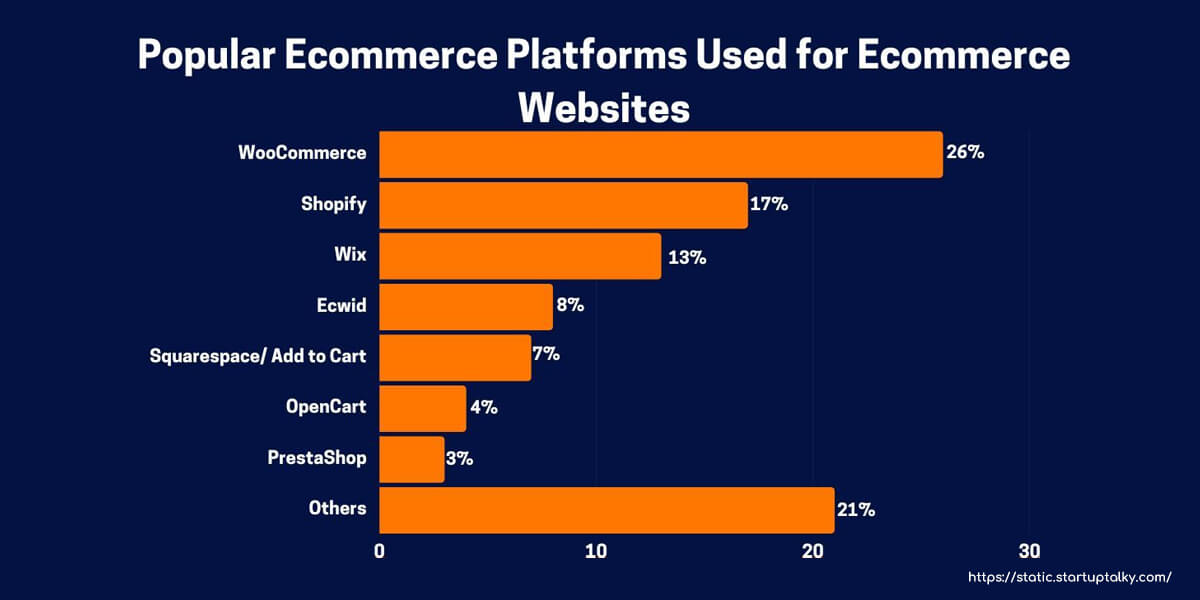
1. Identifying Target Audience and Market
Research the target audience by identifying the ideal customers based on factors like demographics, interests, behavior, and purchasing habits. Take a look at competitor’s websites, marketing materials, and customer feedback. Identify their target audience pricing strategies, strengths, and weaknesses.
Develop detailed profiles of the target customers based on the research that helps better understand needs and preferences, and tailor website content and design to appeal to customers.
Conduct market research by using tools like Google Analytics, Social Media Insights, and Customer Surveys to gather data on the target audience and market that will help to make informed decisions about product offerings, marketing strategies, and website design for e-commerce development services.
2. Setting Clear Business Goals and Objectives
It is important to decide business goals and objectives for the eCommerce website development services such as increasing sales, expanding the customer base, or increasing brand awareness.
- Define a unique selling proposition that sets the eCommerce website apart from competitors.
- Conduct current market trends, customer behavior, and the competition.
- Set specific, measurable, achievable, relevant, and time-bound goals.
- Determine the revenue goals that align with overall business objectives.
- Define marketing and advertising strategies.
- Prioritize customer experience by focusing on providing a seamless and user-friendly experience.
- Set operational and financial goals such as targets such as profit margins and return on investment.
- Regularly review and adjust as needed based on market trends, customer feedback, and business performance.
Top CMS eCommerce Development Platforms for Online Business!
Get the Details3. Choosing the Right eCommerce Platform
First of all, eCommerce is an all-in-one software development services that empowers businesses to do online businesses seamlessly and to manage their websites easily. The platform enables businesses to manage all their online business activities in a single place including marketing, and sales.
An E-commerce platform is perfect for online businesses to frame and convey what they are efficiently offering to their customers. The platform plays a key role in creating engagement between businesses and customers.
Picking the right and best eCommerce platform to cater to the needs is key for a business to achieve success. Apart from that, it is highly recommended to go for the service provider who is prolific in building custom ecommerce development solutions.
Here is a List of a Few Tips and Considerations for Selecting the Right eCommerce Platform.
A. E-commerce Platform Comparison
When selecting a platform for eCommerce Store Development, it’s important to compare the various features available, the level of customization, and the pricing models of each platform. Some popular platforms to consider are Shopify, BigCommerce, Magento, and WooCommerce.
B. Popular eCommerce Platforms and Their Pricing Models
- Shopify – Shopify offers a range of pricing plans, from $29/month to $299/month, depending on the features and customization options businesses require.
- Magento – Magento offers both an open-source and an Enterprise Edition platform. The open-source edition is free, while the Enterprise Edition is paid.
- WooCommerce – WooCommerce is a free open-source platform that can be used to create an eCommerce website.
- BigCommerce – BigCommerce offers a range of plans, from $29.95/month to $249.95/month.
C. A Fully Hosted vs. Self-hosted solutions
Having a subscription-based model, in a fully hosted solution, a third-party provider manages the hosting infrastructure. It includes all the hosting aspects, including server maintenance, technical support, security, and so forth.
On the contrary, the user is taking care of the setup and maintenance of the hosting infrastructure in a self-hosted setup. It includes installing software, buying server space, managing updates and backups, etc.
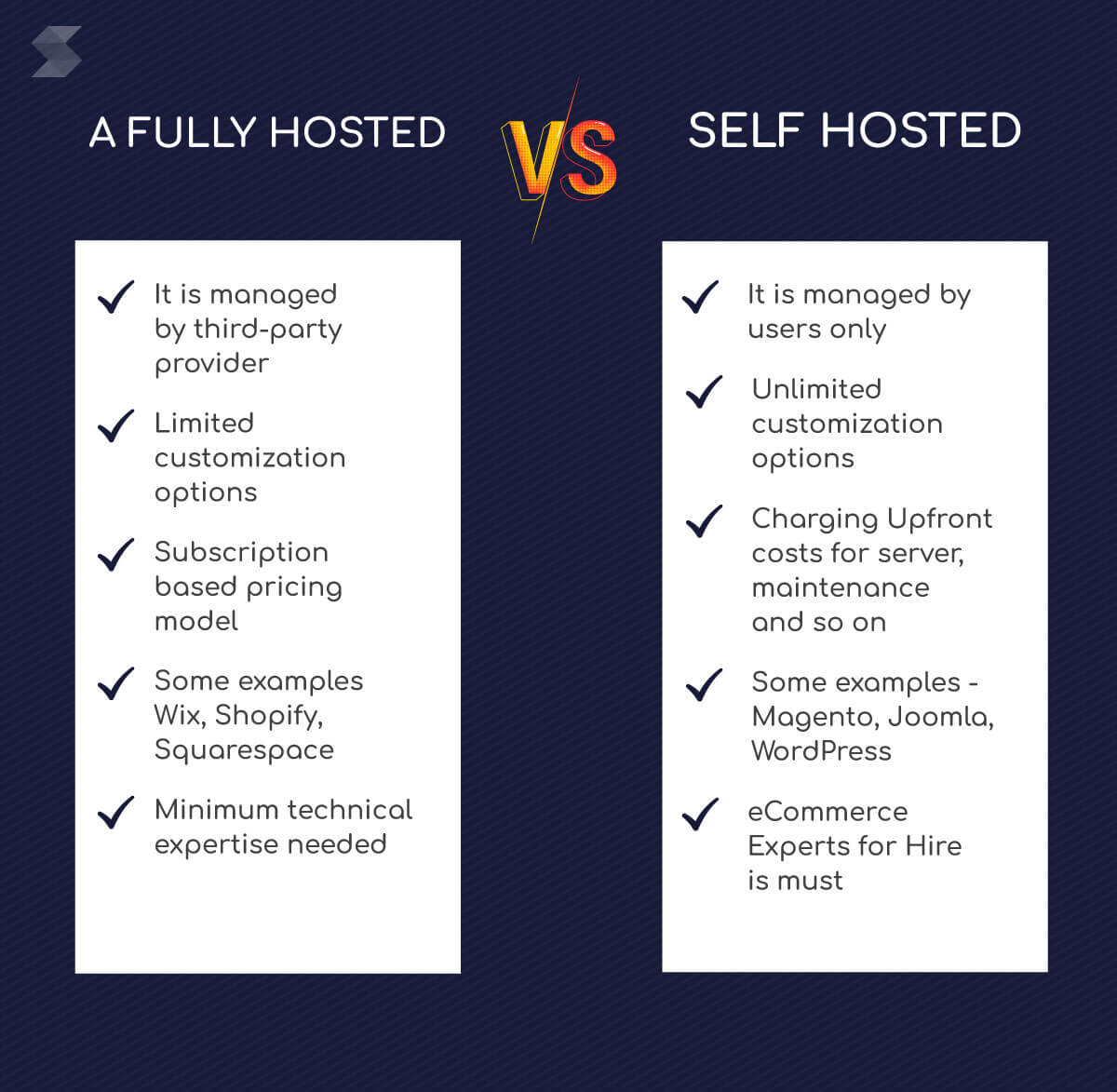
Struggling to spot the right platform for achieving the goals and objectives of online businesses! Well, consider approaching a reliable and reputed eCommerce service provider. Professionals and eCommerce experts can analyze business operations thoroughly and suggest the right platform.
4. Additional Costs for Premium Features and Plugins
A. List of Features
- Advanced product customization tools- Premium themes, a premium domain like .com or .net, to hire a developer to create custom code.
- Advanced reporting and analytics- SSL certificate to ensure all sensitive information, such as credit card details, is encrypted and secure.
- Marketing and SEO Tools- Invest in email marketing tools, social media advertising, and SEO plugins.
- Payment Gateway- Square, PayPal, and Stripe are examples of popular payment gateways.
- Security Plugins- Invest in security plugins to protect enterprises’ websites from cyber threats and hacking attempts depending on the level of protection and features offered.
B. Customization and Features
i. Factors Influencing the Cost of Custom Design
- Complexity of design requirements, Creating complex designs and details needs more time and money, which higher the price.
- The number of pages or views, the more pages, and customizations, the higher the cost of design.
- Functionalities and Features such as product search, shopping cart, checkout process, and payment gateway. These features might charge a percentage of each transaction or a set monthly fee.
- Integration with third-party services such as inventory management, shipping, or CRM systems.
- Visual and Graphic Elements like Images, videos, animations, and custom illustrations impact the cost of custom design.
- Maintenance and updates include SSL certificate, Domain name, web hosting, website keep-up, CMS, Tech support, system maintenance, and website Analytics Reports. It can range in price from $50 to $200 a month, depending on the features and services offered.
ii. Costs Associated With Specific eCommerce Store Features
Here are the approximate costs for the additional eCommerce features businesses may seek to enhance their eCommerce website.
- Web Hosting $100-$1200 Per Year
- Contenting Management System- $500- $800 Per Year
- Product Filters – $500-$1,000
- Payment Gateway Integration – $500-$2,000
- Search Engine Optimization (SEO) – $500-$2,000
- Reviews – $500-$2,000
- Product Recommendations – $500-$2,000
- Abandoned Cart Recovery – $500-$2,000
- User Ratings – $500-$1,000
- Multi-Currency Support – $500-$2,000
- Multi-Language Support – $500-$2,000
- Social Login – $500-$2,000
- eCommerce Website Maintenance- $500-$1000/Year
Building advanced features onto an online shopping site requires significant investments. A smooth checkout needs expert eCommerce developers and eCommerce Store designers. Retailers must strategically select features that closely align with core business objectives and provide clear ROI through increased revenues and higher conversion rates. With careful planning and execution, investment in the right eCommerce features pays dividends.
Remark: cost may vary as per the service providers.
5. Deciding on the Types of Products to Sell
The product selection for new e-commerce website development should take several factors, including market demand, competition, profit margins, and own interests and areas of expertise. Making educated decisions can be aided by researching well-liked products in the niche, spotting unique or niche products, and comprehending the requirements and preferences of the target market.
- Identify products people are passionate about- To find feasible product ideas that people are passionate about, conduct market research to learn about current trends and customer needs in the industry.
- Run on trends early- Keep on top of the most recent market trends and understand the goods that demand right now. Embracing trends at the outset can significantly benefit the eCommerce web solution.
- Serve niche segments- Building brand awareness, online traffic, and eventually new and returning customers can be achieved by catering to a passionate niche audience.
- Take inspiration from social media- Social media is an excellent resource for deciding about the products that people are enthusiastic about. Search for trending hashtags and keywords on social media sites such as Facebook, Instagram, and Twitter.
6. Budget Considerations
- Determine a budget for development costs:- This would include the price of a web developer, designer, and any additional experts that might be required.
- Estimate the cost of hosting:- This includes the price of the domain for registration, website hosting, and any other hosting-related costs.
- Calculate the cost of any third-party integrations or services:- This could include any additional services required for the website, shipping charges, or fees associated with processing payments.
- Estimate the cost of managing the website:- This covers the price of any maintenance for the website, content upgrades, customer support, etc.
- Estimate the cost of marketing and advertising:- This could involve email campaigns, social media advertisements, SEO, etc.
- Consider the cost of any additional resources:- Any tools, software, or other resources required to operate the website may fall under this category.
Top 4 Factors to Consider When Developing an eCommerce Website

1. Importance of User-Friendly Design
When designing an e-commerce website, it is crucial to consider user-friendly design. It refers to the ease of use and accessibility of the website for visitors. The user-friendly design of an e-commerce development solution can have a significant impact on its overall performance.
A visually appealing design for E-Commerce can build a positive brand image and draw in and keep customers. Using a unified color scheme, excellent images, and a simple layout are all necessary for creating visual appeal.
2. Mobile Responsiveness
- An e-commerce web development solution:- must be mobile responsive because an increasing number of people are using smartphones for online shopping and browsing. It means that websites ought to be user-friendly on touchscreen devices and suited for smaller screens. In addition to being essential, mobile responsiveness improves search engine rankings. Google has declared that search results will give preference to mobile-friendly e-commerce web design.
- Incorporating a visually appealing layout:- In e-commerce website design, it is essential to create aesthetically pleasing and well-structured product pages to deliver a positive customer experience. It entails utilizing uncomplicated and uncluttered layouts, adding ratings and reviews for the products, and utilizing visual components like 360-degree views and product videos. By hiring Ecommerce developers from reliable eCommerce UI/UX Design Services Agency, businesses can boost sales and give customers a satisfying experience by emphasizing product display and presentation on the websites.
3. Navigation and Site Structure
When creating an eCommerce Development Solution, navigation and site structure are also crucial factors to consider. These elements have a direct bearing on user experience and have a significant impact on conversions and sales. Two crucial factors for site structure and navigation are as follows:
- Ease of Navigation
An e-commerce website should have simple, intuitive navigation. To help users find what they’re looking for quickly, this means having a menu that is easy to navigate and well-organized, a search bar, and breadcrumbs.UX Design for your eCommerce Store plays an important role as a high bounce rate and frustration can result from cluttered or confusing navigation.
- Clear Site Structure
An e-commerce store’s structure should be rational and well-organized to facilitate users’ ability to locate products and navigate between pages. Having distinct categories, subcategories, and product pages with pertinent data are examples of this. Additionally, a well-organized website enhances visibility in search engine optimization and makes it easier for people to find the website in the top SERP.
4. Branding Elements
This is an additional important factor that should be considered when creating a website since it may help customers recognize and remember the brand. This is an additional important factor that should be considered when creating a website since it may help customers recognize and remember the brand. A consistent and professional website appearance can be achieved by integrating branding elements such as logos, colors, and fonts. These are some branding elements and essential tips that not only ensure staying competitive but also position your business by fostering credibility and loyalty in the market.
Having a strong brand helps to manage eCommerce Store Development strategically as opposed to arbitrarily. It inspires all parties involved to work toward a goal. Therefore, a strong branding strategy has the potential to be an extremely successful eCommerce website Development Company.
What you Need to Consider while Redesigning a Business Website?
Let’s DiscussKey Attributes of High-Performance eCommerce Store
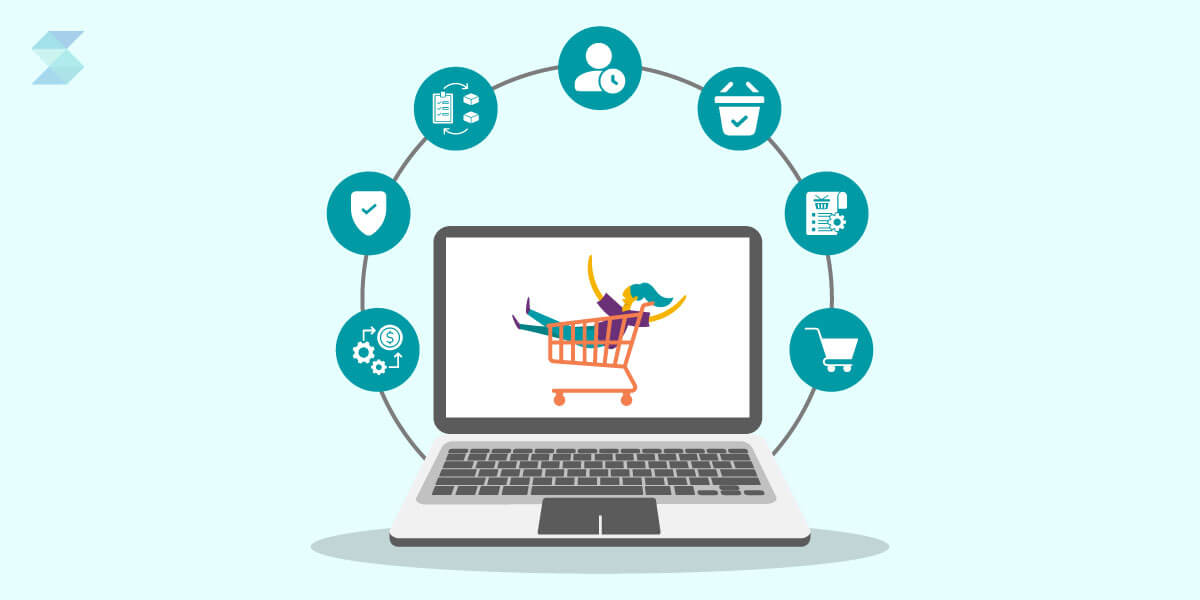
1. Product Catalog Management
The product catalog management system is among an e-commerce website’s most crucial features. Assigning categories and subcategories, adding product descriptions, photos, and prices, and editing and deleting products are all included. In addition, it has functions like product filtering and search that make it simple for users to find what they want. A properly maintained product catalog can significantly improve user experience and facilitate customer purchases.
2. Shopping Cart and Checkout Process
Another crucial feature of an e-commerce website is the shopping cart and checkout process. It should be easy for customers to review and edit their orders before completing the final payment through a streamlined checkout process. Customers should be able to select from a variety of payment methods during this process, including bank transfers, digital wallets, and credit/debit cards.
3. Payment Gateways Integration
To facilitate online payments, a website owner needs to integrate third-party Payment gateways. It serves as a link between the consumer’s bank or Credit Card Company and the e-commerce website, guaranteeing safe and easy transactions. Several well-known payment gateways are Authorize.net, Stripe, and PayPal. Transaction fees and setup costs are crucial considerations when selecting a payment gateway because they can affect a company’s profitability.
- Overview of Different Payment Gateways
ECommerce businesses have a wide variety of payment gateway options to enable online transactions. Traditional merchant accounts gateways like Stripe and PayPal allow the processing of credit cards directly. Third-party payment processors like Square and Braintree offer seamless integration without requiring a merchant account. Mobile and digital wallets like Apple Pay, Google Pay, and Amazon Pay facilitate one-click payments using consumer accounts.Local payment methods like bank transfers or cash collection cater to specific regional customer preferences. Fraud prevention and PCI compliance services are offered by gateways like Signifyd and TokenEx. Payment gateways also provide recurring billing, invoicing, global payment capabilities, loyalty programs, and other features.
As payment gateways come in a variety of forms, each has its own features and cost structure. For instance, PayPal is a well-liked option for small businesses because it only charges a flat fee per transaction rather than setup or monthly fees. Contrarily, Stripe has a higher transaction fee but provides features like multi-currency support and recurring payments.
It’s critical to research and compare the options to decide which payment gateway option is best for websites like custom eCommerce development services.
- Transaction Fees and Setup Costs
Payment gateways charge transaction fees on each purchase a customer makes. These costs may differ based on the payment gateway used and the kind of transaction (bank transfer or credit card, for example). Furthermore, there exist payment gateways that impose setup or monthly fees for the use of their services. When selecting a payment gateway, it is crucial to take these expenses into account because they have an impact on a company’s overall profitability.
- List of Factors to be noted when selecting a Payment Gateway
Considerations for selecting a payment gateway include a number of things. These include transaction fees and setup costs, the types of payment methods supported, security features, and integration of the e-commerce platform with existing online services. It is also vital to confirm that the payment gateway is compatible with the target market, as certain payment methods may not be widely used in certain regions.
4. Inventory Management
Inventory management is crucial for eCommerce Store Development services, as it involves tracking and managing product stock levels. With the help of this feature, businesses can monitor the supply and avoid overselling. Additionally, it lets organizations automate the process of placing new product orders and set up alerts for low stock levels. Order fulfillment delays can be avoided and client satisfaction can be guaranteed with effective inventory management.
5. Security Features
As ecommerce stores handle sensitive consumer data like credit card numbers, security is a major concern. While eCommerce Store Development, e-commerce web development agencies should have security features like data encryption and SSL (Secure Sockets Layer) encryption to guarantee the security of customer data. These features guarantee that client data is encrypted and out of the hands of unauthorized individuals.
6. User Account Management
E-commerce websites must have user account management because it enables users to register for accounts and store credit card and personal data for later use. This feature also enables businesses to track customer orders and provide personalized recommendations based on their purchase history. User account management has the potential to boost client loyalty and the overall shopping experience.
Things to Look Before Finding eCommerce Web Solutions Provider
Read the Full StoryHow to Choose the Best Domain Name and Hosting?
1. For Selecting a Domain Name
- Remember that choosing a short domain name that must be 6 to 14 characters in length makes it easier to remember.
- Make sure that the domain name accurately reflects the company or brand.
- Avoid adding hyphens, numbers, double letters, or special characters in the domain name.
- It is advisable to incorporate business-related keywords in the domain name.
- Make sure the domain name is fully original and SEO-friendly for the new website models.
- Try for names that are not protected by trademarks or copyrights, and confirm availability.
- Pick a domain extension (.com, .online, .store, .shop, .biz, etc.) that is suitable for the company.
2. For Choosing a Reliable Hosting Provider
- Research and compare different hosting providers to find the best fit for the business niche. Some of the popular hosting service providers are GoDaddy, BlueHost, WPEngine, etc. provide the best services along with excellent customer support. Knowing your eCommerce business’s requirements, choose web hosting options.
- Consider the type of hosting (shared, VPS, dedicated) based on a business website’s traffic and requirements.
- Look for a hosting provider with good uptime, customer support, and security features.
- Check for additional features such as email accounts, website builder, and SSL certificates.
- Read reviews of web hosting companies and ask for recommendations from other website companies.
- It is recommended to consider features and value rather than focusing on the cost while buying a hosting plan for your eCommerce store. A web hosting company that offers the lowest price may also have slow servers, subpar customer support, frequent outages, or ties to thousands of unprofessional websites.
3. For Configuring Domain and Hosting Settings
Most eCommerce businesses think that configuring domain and hosting settings requires technical knowledge, however, it is easier than you may think. Here is technical assistance that ensures an easy domain configuration and hosting setup.
- Make sure that the domain is correctly linked to the hosting service provider like Access Domain Registrar Account name server setting and so on.
- Set up DNS records correctly to ensure the proper functioning of the new eCommerce Store Development.
- Configure email settings for the domain.
- Set up backups and security measures for the website.
- Keep track of the hosting plan’s storage and bandwidth to avoid any unexpected charges.
- Regularly monitor and update the domain and hosting settings as needed.
Still, finding difficulty in the domain and hosting setup? Solvios has a team of experts that provides technical assistance for the configuration process of your eCommerce store and helps in establishing an online presence.
Hidden Costs Evaluation in Choosing Web Hosting
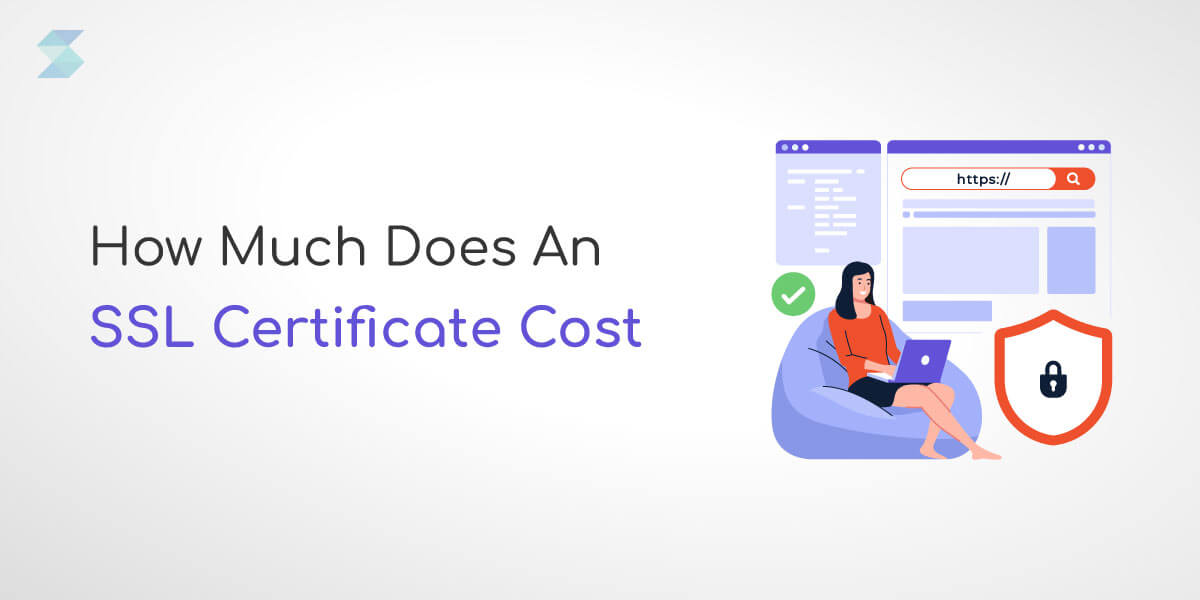
1. Domain Registration and Renewal Fees
When choosing web hosting, domain registration and renewal fees are some considerations that might not be immediately apparent. While some web hosting providers offer a free domain name for the first year, domain renewal fees can add up over time. This can truly save some more time when looking through registrars for free domain names.
2. SSL Certificate Costs
The cost of SSL certificates is another hidden expense to consider. Secure Sockets Layer (SSL) certificates are necessary to protect data transmission on websites, particularly when handling sensitive data like credit cards or personal information. Although some web hosting companies include basic SSL certificates in their packages, advanced-level security features are typically extra expensive. In another scenario, an SSL certificate could have an additional cost.
3. Security and Compliance Expenses
Web hosting comes with costs related to security and compliance that might not be immediately apparent. It is frequently necessary to make additional investments in security measures like firewalls, malware detection, and regular security audits to protect the website from cyber threats and ensure compliance with industry regulations.
These expenses should be part of the overall web hosting cost as they are crucial for safeguarding the website and maintaining the visitor’s trust. The best course of action is to carefully review the security features that the web hosting company provides.
4. Unexpected eCommerce Store Development Challenges
In addition to the more obvious expenses, there may be unexpected eCommerce web development challenges with web hosting. These can include costs for going over the bandwidth allotted, paying for more technical support than it needs, or paying for extra features or integrations that the eCommerce website needs as it gets bigger. It is crucial to thoroughly go over the terms and conditions of web hosting packages to prepare and budget for any unforeseen expenses that might occur.
Tips for Optimizing Your Hosting Expenses
1. Prioritizing Features Based on Business Goals
- Before choosing a web hosting plan, it’s crucial to prioritize essential features and website requirements. It means focusing on the elements that are vital for the website’s functionality and achieving business goals while being mindful of cost limitations.
- Identify the core features the website needs to fulfill its purpose. For instance, a secure and user-friendly shopping cart functionality should be a top priority for an eCommerce Store Development.
- Focus on creating compelling and informative copy, captivating visuals, and any multimedia elements that enhance the website’s overall user experience.
- Consider the content that effectively reaches the message and engages the target audience.
2. Negotiating with Service Providers
- Many web hosting providers offer discounts and deals for long-term agreements, so compare pricing plans from different providers.
- Look for any hidden costs or additional charges that may be linked with certain packages.
- Take time to explore various options and gather information about different providers in the market.
- Find those that provide reasonable prices without sacrificing features and quality.
- Look into different hosting providers, eCommerce Store Development agencies or hosting companies, and website builders that fit within a budget.
3. Plan for Scalability to Avoid Future High Costs
Choosing scalable platforms, flexible hosting, responsive design, optimizing SEO without costly tools, and remaining flexible to changing website needs are all part of planning for future scalability and growth within budget. Considering these factors ensures that the ecommerce website development company continues to grow and achieve its goals without exceeding the budget.
The Best Ecommerce Development Process To Follow
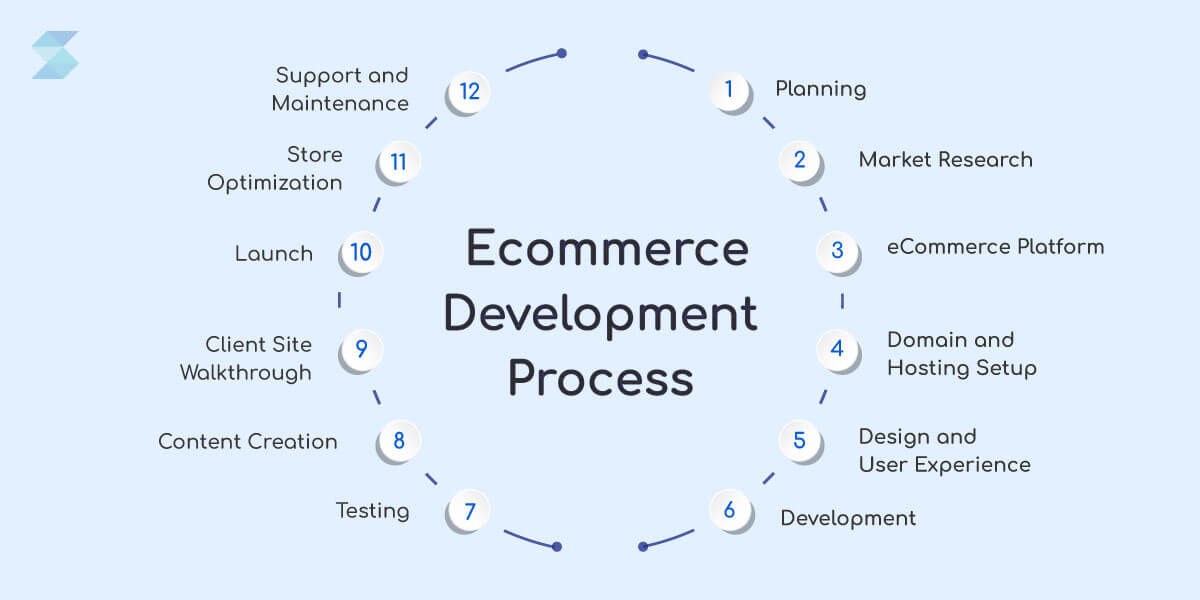
1. Planning
Business people with an expectation to engage in the e-commerce business world must figure out what they are going to sell. Building a good online store around their passions is vital to enhance everyday efforts and achieve business goals.
Businesses are ready to offer potential customers products or eCommerce store development solutions to solve problems they face. They must conduct product research and research regarding the individuals they hope to sell them to. They know the market they enter and what products succeed.
2. Market Research
Entrepreneurs are keen to get online regardless of their expertise about what they want to sell. Market research is one of the most significant things to do to make an informed decision about a company’s investment. Businesses have to check their niche market online and know their e-commerce customers. They must interact with customers through suggestions, feedback, and reviews to understand the customer profile.
3. Choose an eCommerce Platform
Choosing a suitable e-commerce platform, be it Magento or Shopify, NopCommerce, or WooCommerce, helps businesses build their e-commerce store where they make their products available. This is because it is the foundation of the business online. Businesses must decide whether they prefer a hosted platform or a self-hosted platform.
Decide the Best Content Management System
Learn the Benefits4. Domain and Hosting Setup
Entrepreneurs with a business name can go ahead and register the domain name without delay as the suitable URL might be snatched up at later stages of the process of eCommerce Store Development.
5. Design and User Experience (UI/UX)
The ecommerce website must be very responsive and user-friendly. Smart business people have an e-commerce platform that can be viewed on a desktop, any Smartphone with an Internet connection, and other mobile devices.
Specialists in the e-commerce UI/UX design services in Solvios Technology use the most modern resources to provide customized services to their clients. Clients of this company make their wishes about the affordable and best ecommerce platform design services.
6. Development
Professional e-commerce website developers efficiently use world-class resources and ensure 100% satisfaction when offering custom eCommerce development services to their customers. They ensure a robust backend for the user-friendly and organized admin experience. Some of the main admin features are easy changes in inventory, multiple admin logins, and taking stock of orders and other things. A very good user experience is vital to give absolute convenience for all new visitors and existing customers.
Are ready to take your ecommerce business to the next level?
Get Expert Consultation7. Testing
Once the e-commerce website is completed, the next step is testing. Experts in e-commerce website testing test different things like usability, checks for bugs, and customer convenience to ensure a very good shopping experience for every customer. They conduct their testing process on different browsers, across different devices, and different platforms. They combine automated and manual e-commerce website testing.
8. Content Creation
Specialists in e-commerce content creation use modern content management systems to update and edit dynamic content like news and blogs. They recommend a very good content management system to their clients who decide to keep their website updated with eCommerce content marketing strategies supporting their e-commerce business.
A good content marketing strategy for an eCommerce business is useful to successfully tell the brand’s story and communicate what the business online does. It is worthwhile to use text, photos, videos, infographics, and other things to serve customers. The best content strategy properly shapes the e-commerce website’s information architecture.
9. Client Site Walkthrough
In this stage, the technical team demonstrates the eCommerce website to the client. Here, we will showcase user experience, features and essential functionality, customization options, backend administration, and so on. At this stage, the goal is to engage with clients to address their queries, and demonstrate how the developed ecommerce platform meets their business requirements.
10. Launch
Business people can successfully deploy their e-commerce website with the help of a qualified team in this company. This team uploads the website to a hosting server using a FTP program. It adds plugins and SEO tools to make it good and short.
11. Post-Launch Support and Marketing
Businesses can concentrate on the post-launch checklist for their eCommerce store development to successfully run them through very important checkpoints. They can set up Google Analytics, use and create website links, sign up for Google Alerts, manage their reviews, and implement trust seals.
Promoting the e-commerce business is one of the most significant things to achieve business goals. Businesses can spread the word about their brand by using effective methods like pay-per-click advertising, social media marketing, content marketing, and influencer marketing.
12. Ongoing Maintenance, Support, and Optimization
Proper ongoing maintenance of the e-commerce website is very important to reap benefits from it. This is advisable to cater to as many categories of audiences as possible with regular A/B tests. The results of these tests provide valuable insights and an overview of which type of color scheme, copy, and layout appeals to the majority of users. Qualified business people in the e-commerce sector apply the necessary tweaks every so often and make their store shopper-friendly.
The main purpose of e-commerce website optimization is to maximize revenue. Experts in the e-commerce sector conduct keyword research and develop a good keyword strategy, explore the e-commerce keyword analysis, implement the on-page SEO optimization, optimize the product page layout, and create urgency to supercharge their e-commerce store optimization.
Best eCommerce Strategies for Increasing Sales During The Holidays!
Discover the SolutionTips to Hire Developers and Agencies
- Qualities You Should Consider While Hiring eCommerce Developers
When hiring e-commerce developers, it is important to consider experienced technical skills in building ecommerce websites. Look for eCommerce developers who have experience in offering Shopify eCommerce Store Development Services, WooCommerce development services, Magento Development Services, etc. for your eCommerce business.
Consider approaching Solvios Technology, they have a team of professional eCommerce Developers who possess a good understanding of programming languages such as HTML, CSS, JavaScript, and PHP. Additionally, guarantees that developers have excellent problem-solving abilities, and a keen eye for detail, and promotes teamwork.
- Qualities You Should Consider While Hiring eCommerce Development Agencies
Good agencies can understand and meet the business needs, and provide ongoing support after the project is completed.
A good quality of agencies also has a team of developers, designers, and project managers who can work together to ensure the success of the project.
Choosing an ecommerce website development agency like Solvios Technology for your e-commerce business needs is a strategic decision, as they are backed by a team of seasoned eCommerce experts. With a proven track record of delivering 100+ eCommerce projects, Solvios specializes in crafting top-notch e-commerce solutions, boasting expertise in leading CMS platforms such as Shopify, BigCommerce, Magento, NopCommerce, WooCommerce, and more. What sets Solvios Technology apart is its dedicated e-commerce development team, committed to delivering excellence in every project using its in-depth knowledge of various e-commerce platforms.
Looking for Expert Advice on Whether to
Let’s connect!- Flexible Pricing Models for eCommerce Store Development.
When hiring developers or agencies, hourly rates, and project-based pricing models, it is important to discuss and negotiate pricing before starting the project to avoid any unexpected costs. Some developers/agencies charge an hourly rate, while others offer project-based pricing.
Hourly rates can vary depending on the experience and location of the developers/agencies. Project-based pricing may be more suitable for fixed-budget projects, while hourly rates can be beneficial for ongoing maintenance and updates. However, here are some of the flexible hiring models you can find:
- Considerations when Outsourcing eCommerce Store Development
Outsourcing eCommerce store development can be a cost-effective option, considering the time zone difference and how it may affect communication and project timelines. A contract outlining work scope, timelines, and payment terms is crucial, along with ensuring business data security and confidentiality through reputable developers/agencies.
The Impact of Digital Marketing
Learn the Benefits!Effective SEO and Marketing Strategies
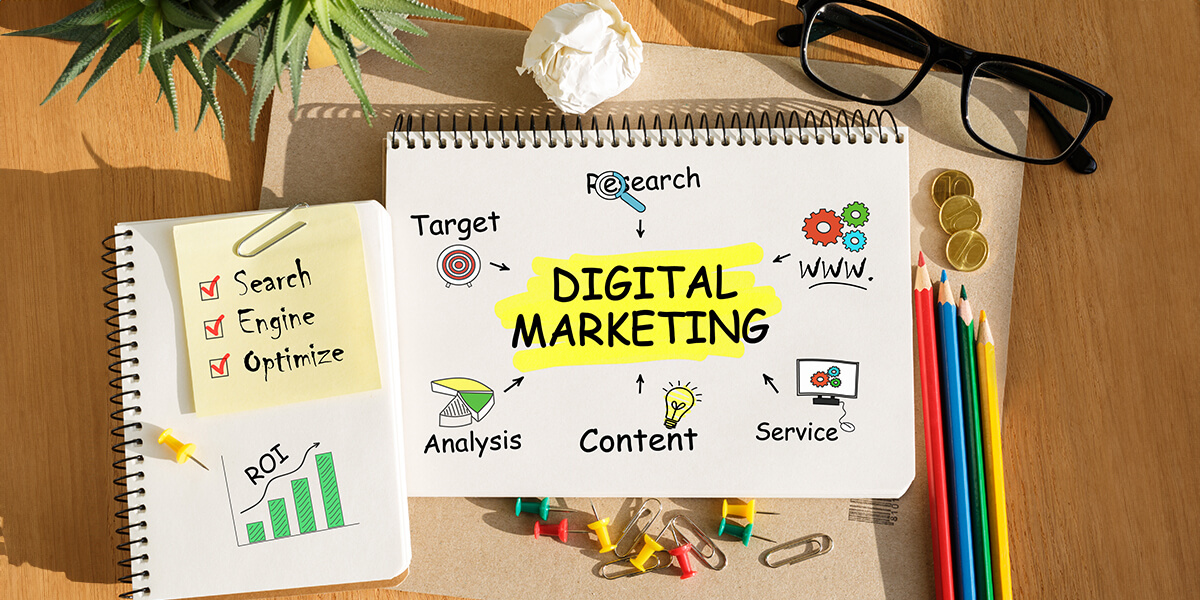
Any eCommerce business needs good SEO and marketing. Make your website search engine friendly to attract more users. Keywords, valuable content, and a faster site can make you show up higher in searches. Paid search ads can further complement SEO efforts by putting a product in front of motivated shoppers. An integrated digital strategy aligns SEO, content, social, email, and paid advertising to acquire customers across channels.
1. Implementing Best SEO practices
- Conduct thorough research to identify relevant keywords, and use tools like Google Keyword Planner, SEMrush, or Ahrefs to find high-volume and low-competition keywords to target.
- Use keywords wisely in headers, Meta descriptions, title tags, and other areas of the on-page content to optimize it.
- Using Alt Tags for Images helps search engines understand what the image is about, which improves the accessibility of websites for visually impaired users.
- A fast-loading website is essential for both user experience and SEO. Use tools such as Google PageSpeed Insights to find and address any issues that might be causing websites to load more slowly. Prefer hiring experts from companies like Solvios Technology that use the latest techniques in their digital marketing services.
- Backlinks from authoritative and relevant websites can significantly improve a website’s ranking. Make requests for backlinks to the website from partners, bloggers, and influencers in the industry.
2. Social Media Integration
- One effective strategy for digital marketing in eCommerce Store Development is to integrate social media.
- It involves creating social media profiles for the business on platforms such as Facebook, Instagram, Twitter, and LinkedIn and linking them to e-commerce websites.
- It allows for increased visibility and reach as well as the opportunity to engage with potential customers through social media.
Would you Like to Implement an Effective Social Media Strategy?
Check It Out!3. Email Marketing Strategies

- Building an email list and sending targeted and personalized emails to subscribers can drive repeat visits and conversions and keep customers informed about new products and promotions.
- Simply collect email addresses from website visitors and send targeted and personalized emails to promote new products, sales, and special offers.
- Make sure emails are well-designed, mobile-friendly, and provide value to the recipient.
4. Online Advertising Options
- Using online advertising options such as Google AdWords, social media ads, and influencer marketing can help drive targeted traffic to the website and increase brand awareness.
- Utilize paid advertising options, such as Google Ads and Facebook Ads, to reach the target audience.
- Collaborating with influencers in a particular niche can help increase brand awareness and reach a wider audience. Partner with influencers to promote the products and share their experiences with the brand.
Conclusion:
The world of eCommerce evolves continuously to meet the growing demands of modern consumers who are always in search of ways to ease their virtual mode of shopping. Businesses and companies may have a range of complexity in developing their eCommerce portals, but approaching the right eCommerce service providers like Solvios Technology will help to reap all those benefits offered by eCommerce.
Utilizing the latest technology and ongoing trends in eCommerce Store development will be the turn-key solution for businesses and enterprises to develop and improve their business lifecycle. Consider engaging with a successful eCommerce venture that understands businesses and enterprises’ intricacies of online selling of products or servicing customers for achieving measurable business results in the virtual world.
Smoothen Your eCommerce Journey with Our Maintenance Services!
Contact UsTags
Related Blog
Want to get started with App Development?
These applications are acquiring enormous prevalence by offering hands-on enterprise mobility solutions for organizations around the globe.
Start A Conversation







